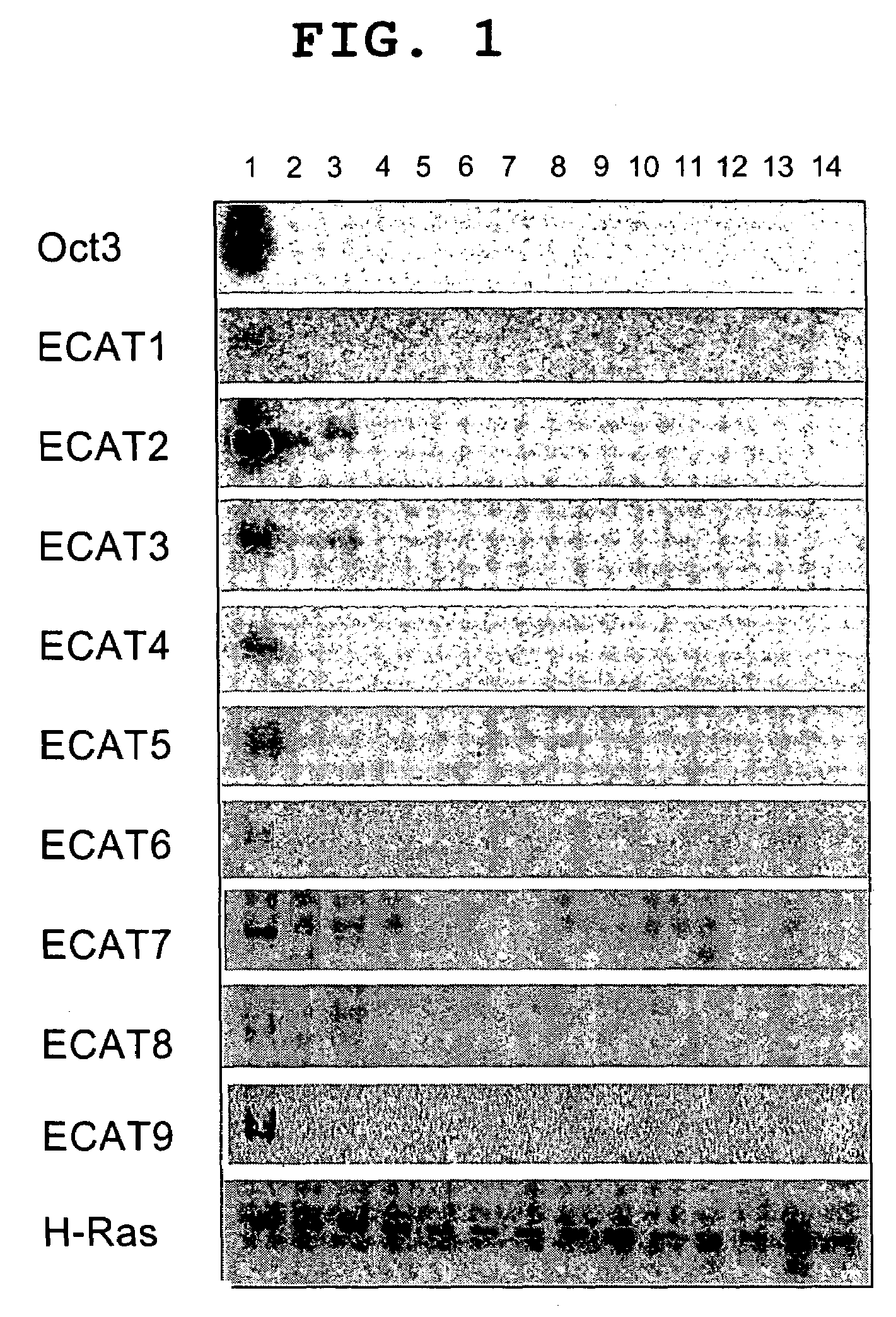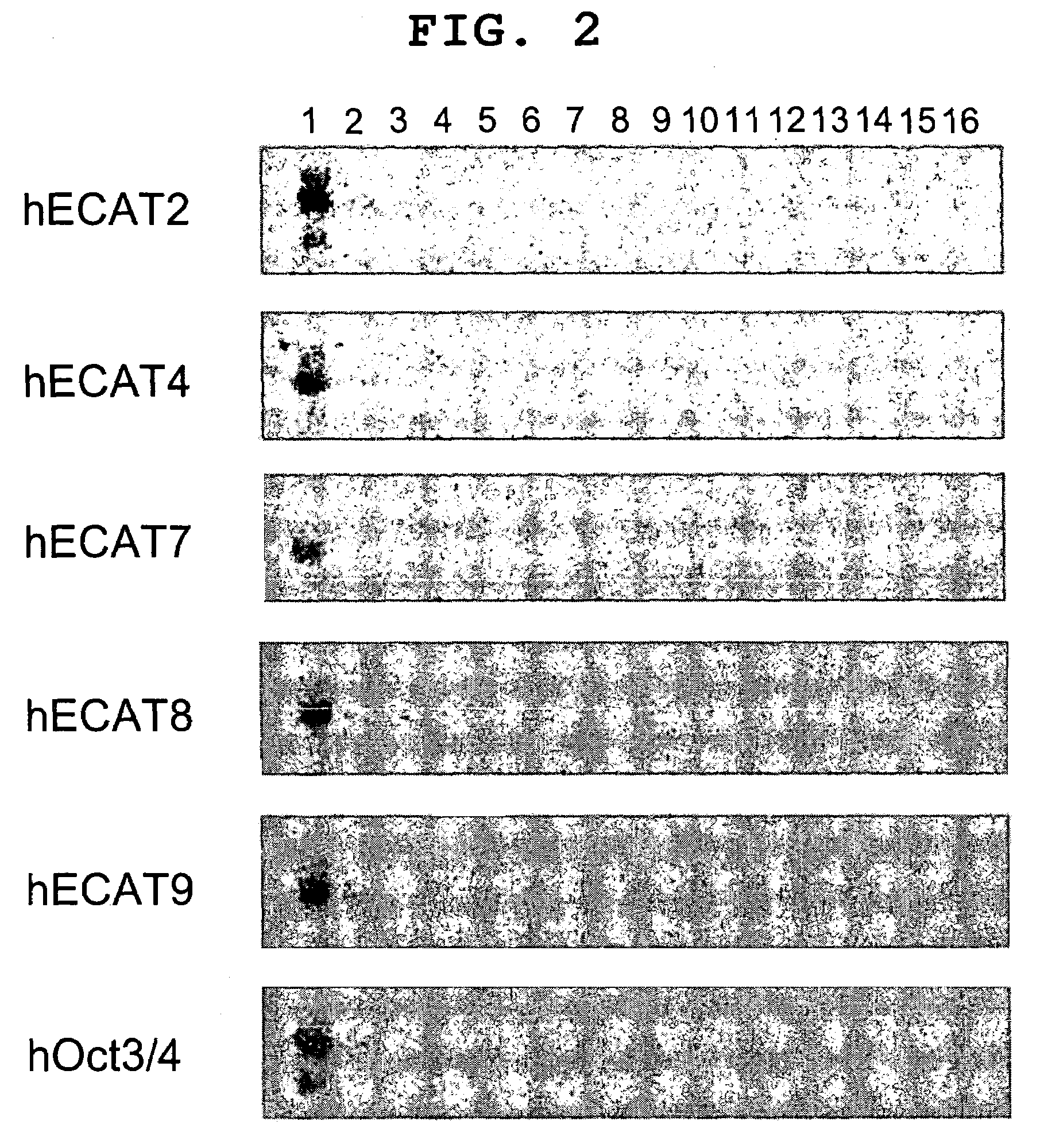Genes with ES cell-specific expression
a technology of es cell and gene, applied in the field of ecat gene (es cell associated transcript gene), can solve the problems of easy human cloning, difficult establishment and maintenance of human es cells, and difficult action of oct-3/4
- Summary
- Abstract
- Description
- Claims
- Application Information
AI Technical Summary
Benefits of technology
Problems solved by technology
Method used
Image
Examples
example 1
Identification of Mouse ECAT Gene
(1) Identification of Candidate Gene by Computer Analysis
(Procedure)
[0092]The EST database was used to identify the candidate genes of ECAT. EST is obtained by randomly extracting a number of cDNA clones from cDNA libraries derived from various cells and organs, analyzing only one reaction of the 5′ or 3′ end sequence thereof and registering same in a public database. ESTs can be said to be a catalog of genes expressed in each cell and each organ. More than one million clones derived from mouse and more than 30000 clones derived from mouse ES cell have been registered.
[0093]As the EST database, Unigene was used. Unigene is prepared by clustering clones of EST, which are considered to be derived from the same gene, and as of Mar. 5, 2001, 79917 sets have been reported for the mouse EST database, where each set consists of at least one EST or known gene.
[0094]As a method of analysis, Digital differential display method was used. This method is used to ...
example 2
Analysis of Known Information of the Obtained ECAT Gene
(1) Blast Search
[0121]EST sequence of 8 genes confirmed to be ECAT genes as a result of Northern blotting was searched using Blast. As a result, the sequences of 3 genes were already reported in papers. ECAT2 gene was reported as gene pH34 that shows a decrease in expression wben EC cell is stimulated with retinoic acid. ECAT3 gene was reported as a mouse protein having F box, whose expression is observed only in orchis and ovary. ECA7 gene was reported as protein DNMT3L similar to DNMT3 that performs DNA methylation. Identification of full length cDNA was tried by the RACE method and translation region was identified for ECAT4 gene, ECAT5 gene and ECAT6 gene. Deducible amino acid sequence was searched using BlastP and it was found that ECAT4 gene has homeobox, ECAT5 gene has homology with cancer gene H-Ras, and ECAT6 gene is similar to keratin. In addition, ECAT9 gene, which was newly confirmed to be ECAT gene, was found to be ...
example 3
Identification of Human ECAT Gene
(1) Blast Search of Human Genomic DNA Database and Human Protein Database
[0123]As a result of Blast search, ECAT2-5, 7, 8 genes were found to have ortholog having an amino acid sequence identical in not less than 50%. For ECAT9 gene, too, hECAT9 gene exists as hGDF3 (Caricasole et al., mentioned above). As regards ECAT1 gene and ECAT6 gene, human ortholog could not be identified.
[0124]As a result of BlastP search, there was no publication of base sequence or amino acid sequence including hypothetical protein, for 3 genes of hECAT3 gene, hECAT5 gene and hECAT8 gene.
PUM
| Property | Measurement | Unit |
|---|---|---|
| temperature | aaaaa | aaaaa |
| nucleic acid | aaaaa | aaaaa |
| drug resistance | aaaaa | aaaaa |
Abstract
Description
Claims
Application Information
 Login to View More
Login to View More - R&D
- Intellectual Property
- Life Sciences
- Materials
- Tech Scout
- Unparalleled Data Quality
- Higher Quality Content
- 60% Fewer Hallucinations
Browse by: Latest US Patents, China's latest patents, Technical Efficacy Thesaurus, Application Domain, Technology Topic, Popular Technical Reports.
© 2025 PatSnap. All rights reserved.Legal|Privacy policy|Modern Slavery Act Transparency Statement|Sitemap|About US| Contact US: help@patsnap.com


